Early Childhood Education: Cultural Diversity, Poverty, and Children with Diverse Abilities
VerifiedAdded on 2023/06/07
|11
|3300
|360
AI Summary
This article discusses the issues of cultural diversity, poverty, and children with diverse abilities in early childhood education in New Zealand. It explores the inclusive approach and strategies for teachers to promote social inclusion and equal rights for all children. The article emphasizes the importance of acknowledging cultural diversity, addressing poverty, and providing a caring and supporting environment for children with diverse abilities.
Contribute Materials
Your contribution can guide someone’s learning journey. Share your
documents today.
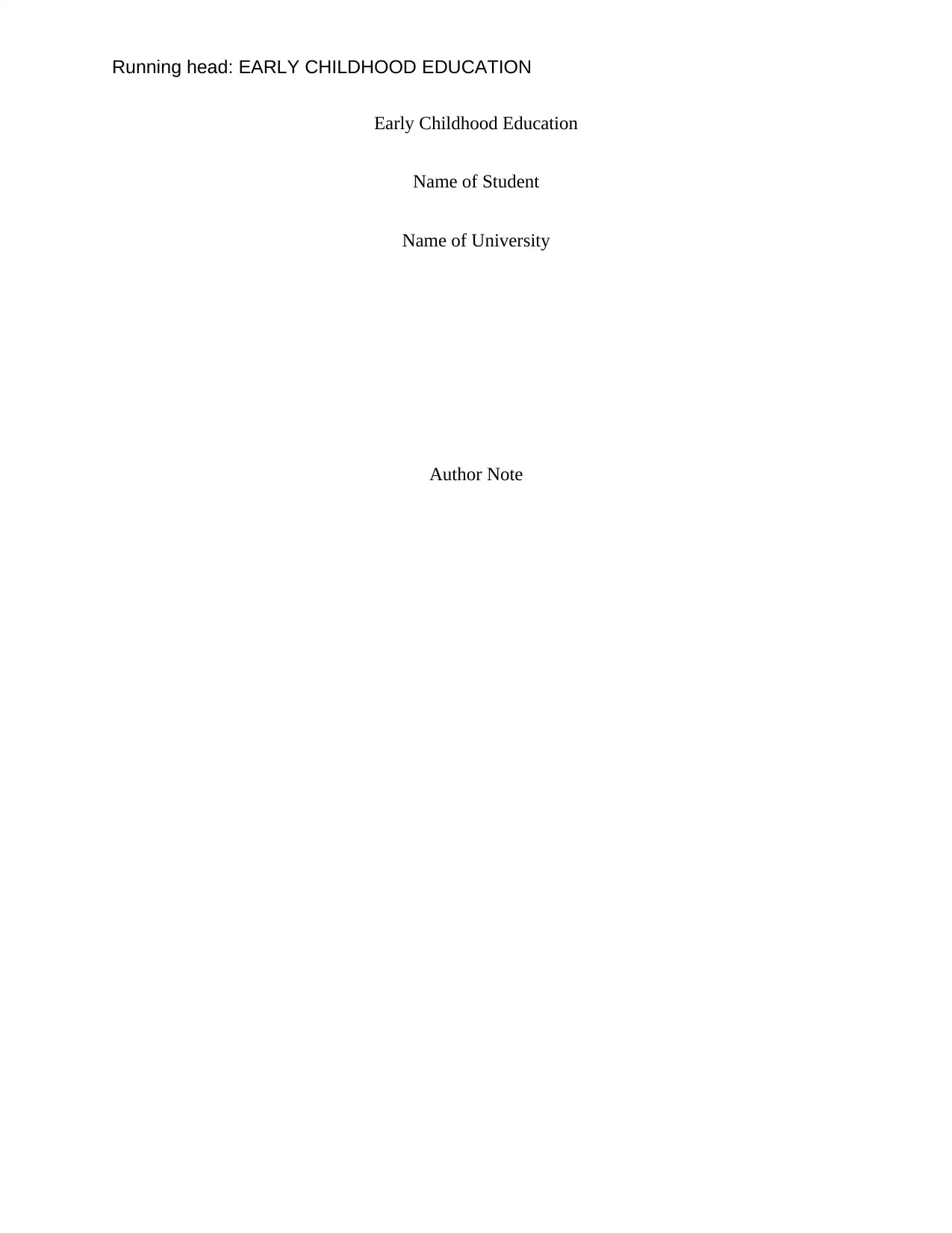
Running head: EARLY CHILDHOOD EDUCATION
Early Childhood Education
Name of Student
Name of University
Author Note
Early Childhood Education
Name of Student
Name of University
Author Note
Secure Best Marks with AI Grader
Need help grading? Try our AI Grader for instant feedback on your assignments.
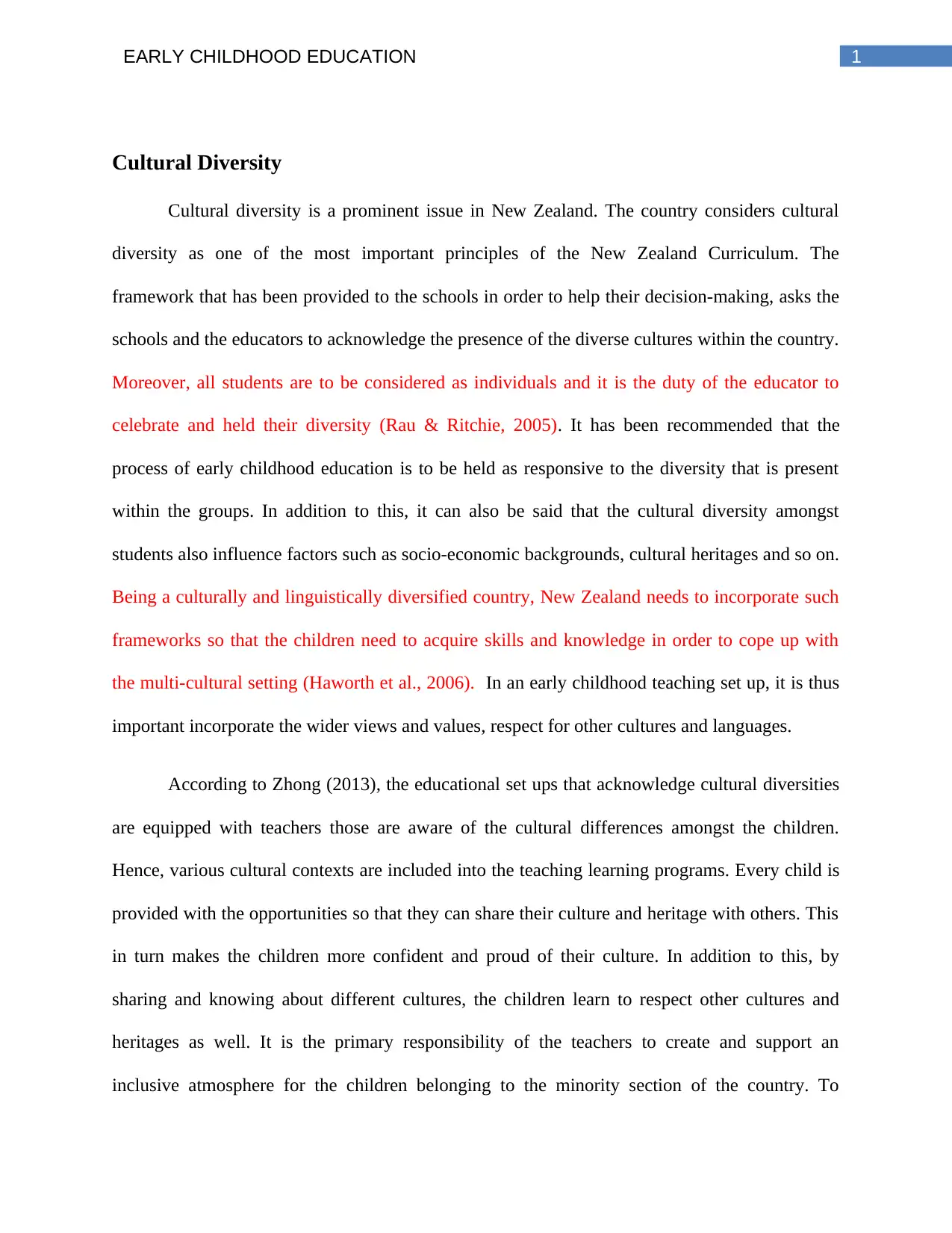
1EARLY CHILDHOOD EDUCATION
Cultural Diversity
Cultural diversity is a prominent issue in New Zealand. The country considers cultural
diversity as one of the most important principles of the New Zealand Curriculum. The
framework that has been provided to the schools in order to help their decision-making, asks the
schools and the educators to acknowledge the presence of the diverse cultures within the country.
Moreover, all students are to be considered as individuals and it is the duty of the educator to
celebrate and held their diversity (Rau & Ritchie, 2005). It has been recommended that the
process of early childhood education is to be held as responsive to the diversity that is present
within the groups. In addition to this, it can also be said that the cultural diversity amongst
students also influence factors such as socio-economic backgrounds, cultural heritages and so on.
Being a culturally and linguistically diversified country, New Zealand needs to incorporate such
frameworks so that the children need to acquire skills and knowledge in order to cope up with
the multi-cultural setting (Haworth et al., 2006). In an early childhood teaching set up, it is thus
important incorporate the wider views and values, respect for other cultures and languages.
According to Zhong (2013), the educational set ups that acknowledge cultural diversities
are equipped with teachers those are aware of the cultural differences amongst the children.
Hence, various cultural contexts are included into the teaching learning programs. Every child is
provided with the opportunities so that they can share their culture and heritage with others. This
in turn makes the children more confident and proud of their culture. In addition to this, by
sharing and knowing about different cultures, the children learn to respect other cultures and
heritages as well. It is the primary responsibility of the teachers to create and support an
inclusive atmosphere for the children belonging to the minority section of the country. To
Cultural Diversity
Cultural diversity is a prominent issue in New Zealand. The country considers cultural
diversity as one of the most important principles of the New Zealand Curriculum. The
framework that has been provided to the schools in order to help their decision-making, asks the
schools and the educators to acknowledge the presence of the diverse cultures within the country.
Moreover, all students are to be considered as individuals and it is the duty of the educator to
celebrate and held their diversity (Rau & Ritchie, 2005). It has been recommended that the
process of early childhood education is to be held as responsive to the diversity that is present
within the groups. In addition to this, it can also be said that the cultural diversity amongst
students also influence factors such as socio-economic backgrounds, cultural heritages and so on.
Being a culturally and linguistically diversified country, New Zealand needs to incorporate such
frameworks so that the children need to acquire skills and knowledge in order to cope up with
the multi-cultural setting (Haworth et al., 2006). In an early childhood teaching set up, it is thus
important incorporate the wider views and values, respect for other cultures and languages.
According to Zhong (2013), the educational set ups that acknowledge cultural diversities
are equipped with teachers those are aware of the cultural differences amongst the children.
Hence, various cultural contexts are included into the teaching learning programs. Every child is
provided with the opportunities so that they can share their culture and heritage with others. This
in turn makes the children more confident and proud of their culture. In addition to this, by
sharing and knowing about different cultures, the children learn to respect other cultures and
heritages as well. It is the primary responsibility of the teachers to create and support an
inclusive atmosphere for the children belonging to the minority section of the country. To
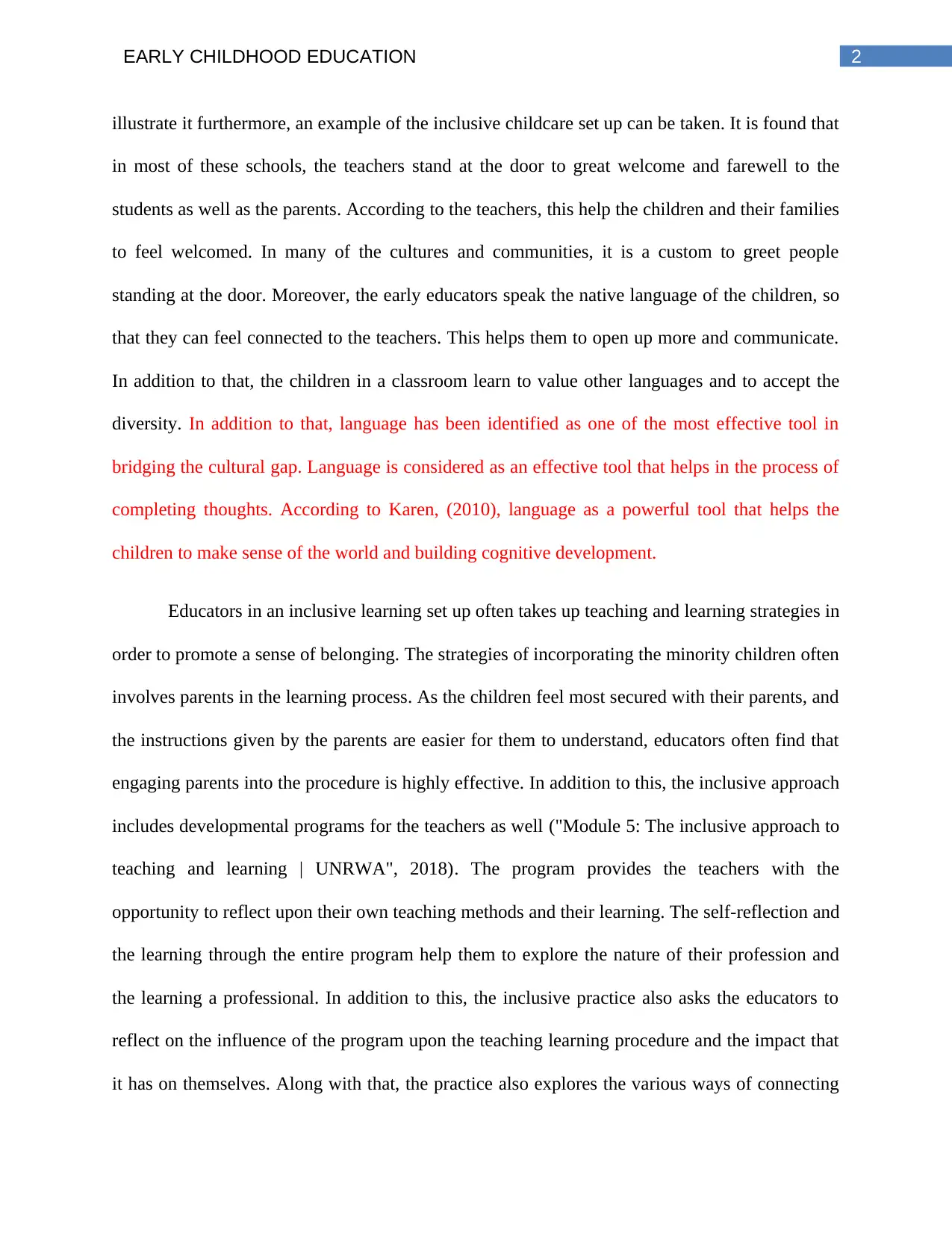
2EARLY CHILDHOOD EDUCATION
illustrate it furthermore, an example of the inclusive childcare set up can be taken. It is found that
in most of these schools, the teachers stand at the door to great welcome and farewell to the
students as well as the parents. According to the teachers, this help the children and their families
to feel welcomed. In many of the cultures and communities, it is a custom to greet people
standing at the door. Moreover, the early educators speak the native language of the children, so
that they can feel connected to the teachers. This helps them to open up more and communicate.
In addition to that, the children in a classroom learn to value other languages and to accept the
diversity. In addition to that, language has been identified as one of the most effective tool in
bridging the cultural gap. Language is considered as an effective tool that helps in the process of
completing thoughts. According to Karen, (2010), language as a powerful tool that helps the
children to make sense of the world and building cognitive development.
Educators in an inclusive learning set up often takes up teaching and learning strategies in
order to promote a sense of belonging. The strategies of incorporating the minority children often
involves parents in the learning process. As the children feel most secured with their parents, and
the instructions given by the parents are easier for them to understand, educators often find that
engaging parents into the procedure is highly effective. In addition to this, the inclusive approach
includes developmental programs for the teachers as well ("Module 5: The inclusive approach to
teaching and learning | UNRWA", 2018). The program provides the teachers with the
opportunity to reflect upon their own teaching methods and their learning. The self-reflection and
the learning through the entire program help them to explore the nature of their profession and
the learning a professional. In addition to this, the inclusive practice also asks the educators to
reflect on the influence of the program upon the teaching learning procedure and the impact that
it has on themselves. Along with that, the practice also explores the various ways of connecting
illustrate it furthermore, an example of the inclusive childcare set up can be taken. It is found that
in most of these schools, the teachers stand at the door to great welcome and farewell to the
students as well as the parents. According to the teachers, this help the children and their families
to feel welcomed. In many of the cultures and communities, it is a custom to greet people
standing at the door. Moreover, the early educators speak the native language of the children, so
that they can feel connected to the teachers. This helps them to open up more and communicate.
In addition to that, the children in a classroom learn to value other languages and to accept the
diversity. In addition to that, language has been identified as one of the most effective tool in
bridging the cultural gap. Language is considered as an effective tool that helps in the process of
completing thoughts. According to Karen, (2010), language as a powerful tool that helps the
children to make sense of the world and building cognitive development.
Educators in an inclusive learning set up often takes up teaching and learning strategies in
order to promote a sense of belonging. The strategies of incorporating the minority children often
involves parents in the learning process. As the children feel most secured with their parents, and
the instructions given by the parents are easier for them to understand, educators often find that
engaging parents into the procedure is highly effective. In addition to this, the inclusive approach
includes developmental programs for the teachers as well ("Module 5: The inclusive approach to
teaching and learning | UNRWA", 2018). The program provides the teachers with the
opportunity to reflect upon their own teaching methods and their learning. The self-reflection and
the learning through the entire program help them to explore the nature of their profession and
the learning a professional. In addition to this, the inclusive practice also asks the educators to
reflect on the influence of the program upon the teaching learning procedure and the impact that
it has on themselves. Along with that, the practice also explores the various ways of connecting
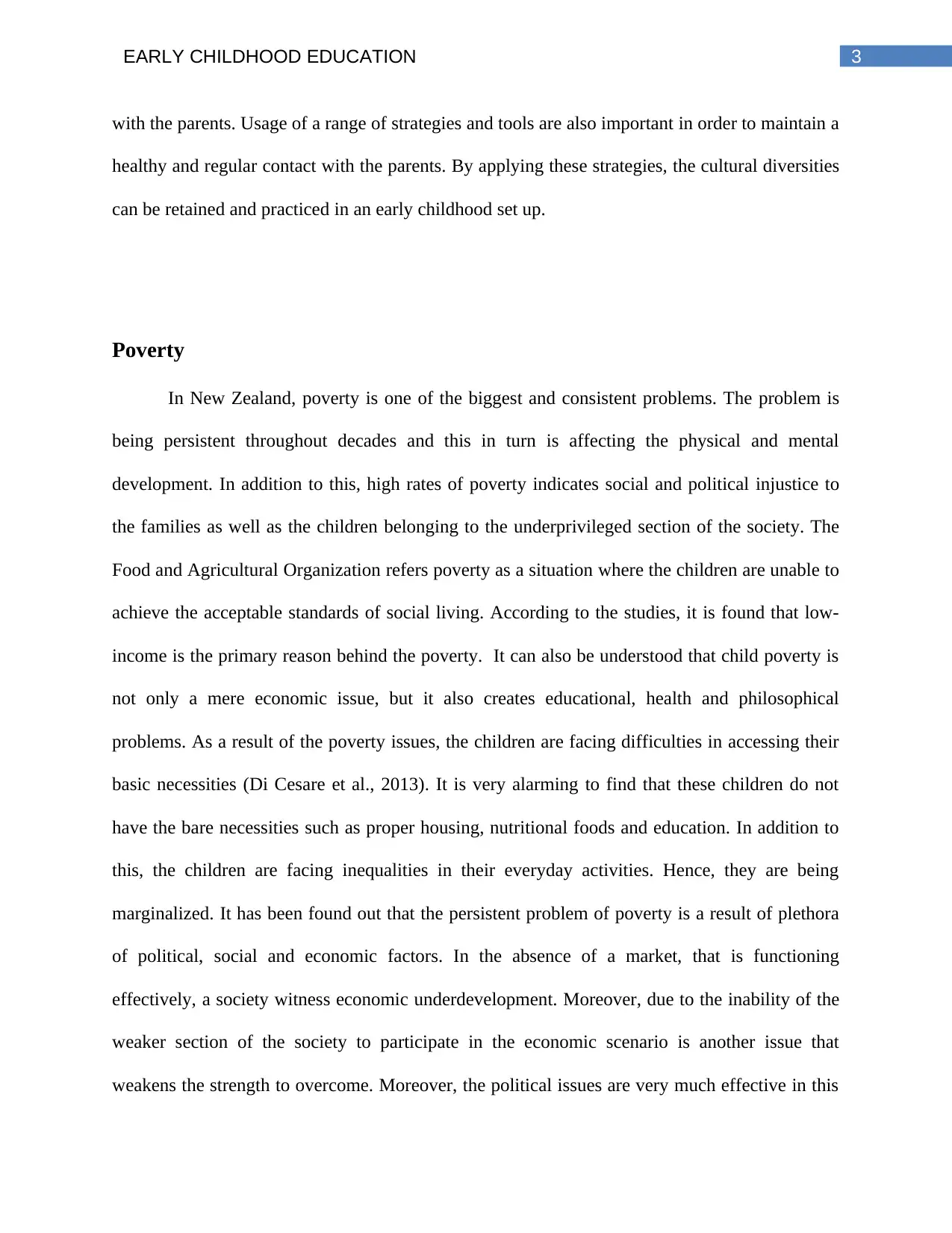
3EARLY CHILDHOOD EDUCATION
with the parents. Usage of a range of strategies and tools are also important in order to maintain a
healthy and regular contact with the parents. By applying these strategies, the cultural diversities
can be retained and practiced in an early childhood set up.
Poverty
In New Zealand, poverty is one of the biggest and consistent problems. The problem is
being persistent throughout decades and this in turn is affecting the physical and mental
development. In addition to this, high rates of poverty indicates social and political injustice to
the families as well as the children belonging to the underprivileged section of the society. The
Food and Agricultural Organization refers poverty as a situation where the children are unable to
achieve the acceptable standards of social living. According to the studies, it is found that low-
income is the primary reason behind the poverty. It can also be understood that child poverty is
not only a mere economic issue, but it also creates educational, health and philosophical
problems. As a result of the poverty issues, the children are facing difficulties in accessing their
basic necessities (Di Cesare et al., 2013). It is very alarming to find that these children do not
have the bare necessities such as proper housing, nutritional foods and education. In addition to
this, the children are facing inequalities in their everyday activities. Hence, they are being
marginalized. It has been found out that the persistent problem of poverty is a result of plethora
of political, social and economic factors. In the absence of a market, that is functioning
effectively, a society witness economic underdevelopment. Moreover, due to the inability of the
weaker section of the society to participate in the economic scenario is another issue that
weakens the strength to overcome. Moreover, the political issues are very much effective in this
with the parents. Usage of a range of strategies and tools are also important in order to maintain a
healthy and regular contact with the parents. By applying these strategies, the cultural diversities
can be retained and practiced in an early childhood set up.
Poverty
In New Zealand, poverty is one of the biggest and consistent problems. The problem is
being persistent throughout decades and this in turn is affecting the physical and mental
development. In addition to this, high rates of poverty indicates social and political injustice to
the families as well as the children belonging to the underprivileged section of the society. The
Food and Agricultural Organization refers poverty as a situation where the children are unable to
achieve the acceptable standards of social living. According to the studies, it is found that low-
income is the primary reason behind the poverty. It can also be understood that child poverty is
not only a mere economic issue, but it also creates educational, health and philosophical
problems. As a result of the poverty issues, the children are facing difficulties in accessing their
basic necessities (Di Cesare et al., 2013). It is very alarming to find that these children do not
have the bare necessities such as proper housing, nutritional foods and education. In addition to
this, the children are facing inequalities in their everyday activities. Hence, they are being
marginalized. It has been found out that the persistent problem of poverty is a result of plethora
of political, social and economic factors. In the absence of a market, that is functioning
effectively, a society witness economic underdevelopment. Moreover, due to the inability of the
weaker section of the society to participate in the economic scenario is another issue that
weakens the strength to overcome. Moreover, the political issues are very much effective in this
Secure Best Marks with AI Grader
Need help grading? Try our AI Grader for instant feedback on your assignments.
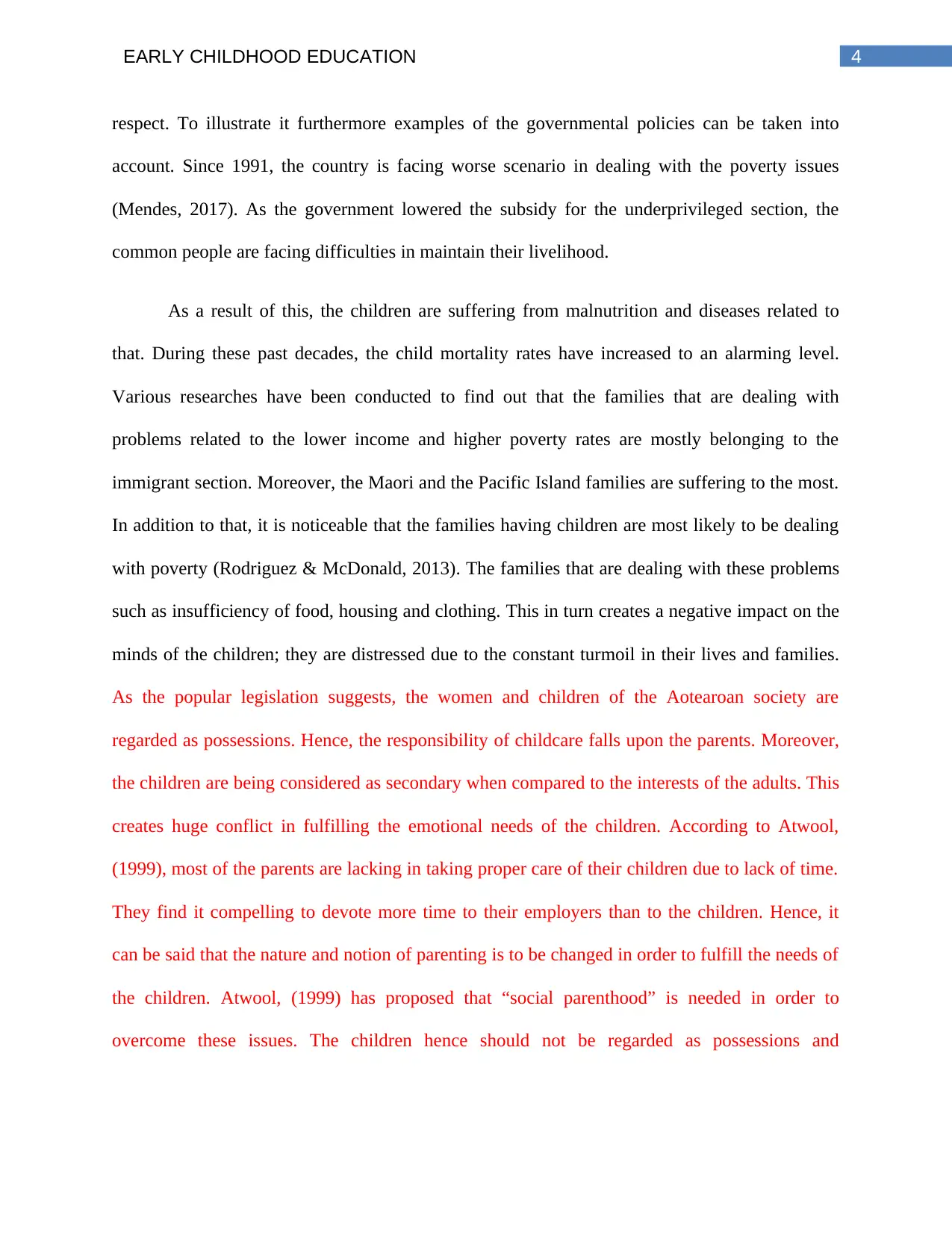
4EARLY CHILDHOOD EDUCATION
respect. To illustrate it furthermore examples of the governmental policies can be taken into
account. Since 1991, the country is facing worse scenario in dealing with the poverty issues
(Mendes, 2017). As the government lowered the subsidy for the underprivileged section, the
common people are facing difficulties in maintain their livelihood.
As a result of this, the children are suffering from malnutrition and diseases related to
that. During these past decades, the child mortality rates have increased to an alarming level.
Various researches have been conducted to find out that the families that are dealing with
problems related to the lower income and higher poverty rates are mostly belonging to the
immigrant section. Moreover, the Maori and the Pacific Island families are suffering to the most.
In addition to that, it is noticeable that the families having children are most likely to be dealing
with poverty (Rodriguez & McDonald, 2013). The families that are dealing with these problems
such as insufficiency of food, housing and clothing. This in turn creates a negative impact on the
minds of the children; they are distressed due to the constant turmoil in their lives and families.
As the popular legislation suggests, the women and children of the Aotearoan society are
regarded as possessions. Hence, the responsibility of childcare falls upon the parents. Moreover,
the children are being considered as secondary when compared to the interests of the adults. This
creates huge conflict in fulfilling the emotional needs of the children. According to Atwool,
(1999), most of the parents are lacking in taking proper care of their children due to lack of time.
They find it compelling to devote more time to their employers than to the children. Hence, it
can be said that the nature and notion of parenting is to be changed in order to fulfill the needs of
the children. Atwool, (1999) has proposed that “social parenthood” is needed in order to
overcome these issues. The children hence should not be regarded as possessions and
respect. To illustrate it furthermore examples of the governmental policies can be taken into
account. Since 1991, the country is facing worse scenario in dealing with the poverty issues
(Mendes, 2017). As the government lowered the subsidy for the underprivileged section, the
common people are facing difficulties in maintain their livelihood.
As a result of this, the children are suffering from malnutrition and diseases related to
that. During these past decades, the child mortality rates have increased to an alarming level.
Various researches have been conducted to find out that the families that are dealing with
problems related to the lower income and higher poverty rates are mostly belonging to the
immigrant section. Moreover, the Maori and the Pacific Island families are suffering to the most.
In addition to that, it is noticeable that the families having children are most likely to be dealing
with poverty (Rodriguez & McDonald, 2013). The families that are dealing with these problems
such as insufficiency of food, housing and clothing. This in turn creates a negative impact on the
minds of the children; they are distressed due to the constant turmoil in their lives and families.
As the popular legislation suggests, the women and children of the Aotearoan society are
regarded as possessions. Hence, the responsibility of childcare falls upon the parents. Moreover,
the children are being considered as secondary when compared to the interests of the adults. This
creates huge conflict in fulfilling the emotional needs of the children. According to Atwool,
(1999), most of the parents are lacking in taking proper care of their children due to lack of time.
They find it compelling to devote more time to their employers than to the children. Hence, it
can be said that the nature and notion of parenting is to be changed in order to fulfill the needs of
the children. Atwool, (1999) has proposed that “social parenthood” is needed in order to
overcome these issues. The children hence should not be regarded as possessions and
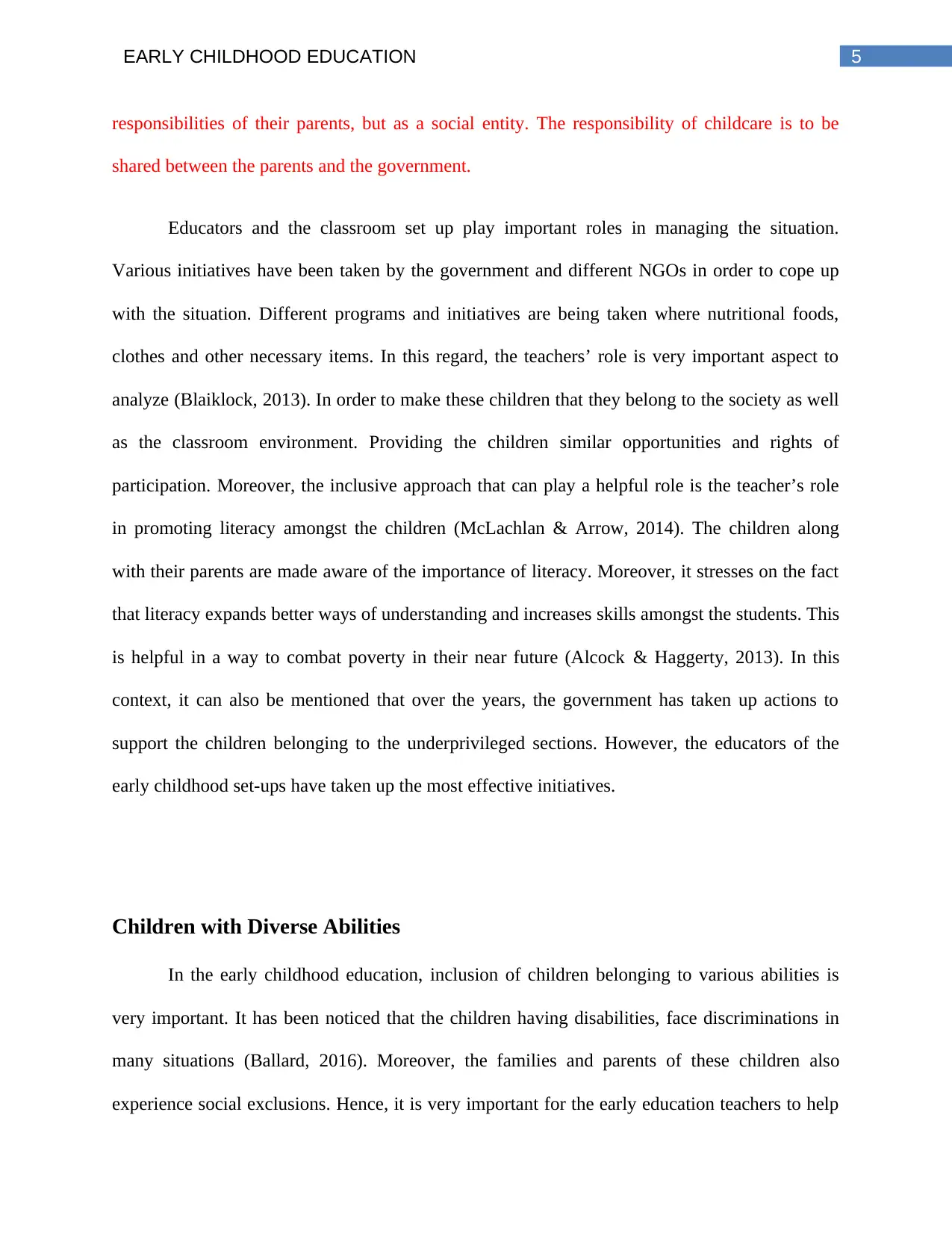
5EARLY CHILDHOOD EDUCATION
responsibilities of their parents, but as a social entity. The responsibility of childcare is to be
shared between the parents and the government.
Educators and the classroom set up play important roles in managing the situation.
Various initiatives have been taken by the government and different NGOs in order to cope up
with the situation. Different programs and initiatives are being taken where nutritional foods,
clothes and other necessary items. In this regard, the teachers’ role is very important aspect to
analyze (Blaiklock, 2013). In order to make these children that they belong to the society as well
as the classroom environment. Providing the children similar opportunities and rights of
participation. Moreover, the inclusive approach that can play a helpful role is the teacher’s role
in promoting literacy amongst the children (McLachlan & Arrow, 2014). The children along
with their parents are made aware of the importance of literacy. Moreover, it stresses on the fact
that literacy expands better ways of understanding and increases skills amongst the students. This
is helpful in a way to combat poverty in their near future (Alcock & Haggerty, 2013). In this
context, it can also be mentioned that over the years, the government has taken up actions to
support the children belonging to the underprivileged sections. However, the educators of the
early childhood set-ups have taken up the most effective initiatives.
Children with Diverse Abilities
In the early childhood education, inclusion of children belonging to various abilities is
very important. It has been noticed that the children having disabilities, face discriminations in
many situations (Ballard, 2016). Moreover, the families and parents of these children also
experience social exclusions. Hence, it is very important for the early education teachers to help
responsibilities of their parents, but as a social entity. The responsibility of childcare is to be
shared between the parents and the government.
Educators and the classroom set up play important roles in managing the situation.
Various initiatives have been taken by the government and different NGOs in order to cope up
with the situation. Different programs and initiatives are being taken where nutritional foods,
clothes and other necessary items. In this regard, the teachers’ role is very important aspect to
analyze (Blaiklock, 2013). In order to make these children that they belong to the society as well
as the classroom environment. Providing the children similar opportunities and rights of
participation. Moreover, the inclusive approach that can play a helpful role is the teacher’s role
in promoting literacy amongst the children (McLachlan & Arrow, 2014). The children along
with their parents are made aware of the importance of literacy. Moreover, it stresses on the fact
that literacy expands better ways of understanding and increases skills amongst the students. This
is helpful in a way to combat poverty in their near future (Alcock & Haggerty, 2013). In this
context, it can also be mentioned that over the years, the government has taken up actions to
support the children belonging to the underprivileged sections. However, the educators of the
early childhood set-ups have taken up the most effective initiatives.
Children with Diverse Abilities
In the early childhood education, inclusion of children belonging to various abilities is
very important. It has been noticed that the children having disabilities, face discriminations in
many situations (Ballard, 2016). Moreover, the families and parents of these children also
experience social exclusions. Hence, it is very important for the early education teachers to help
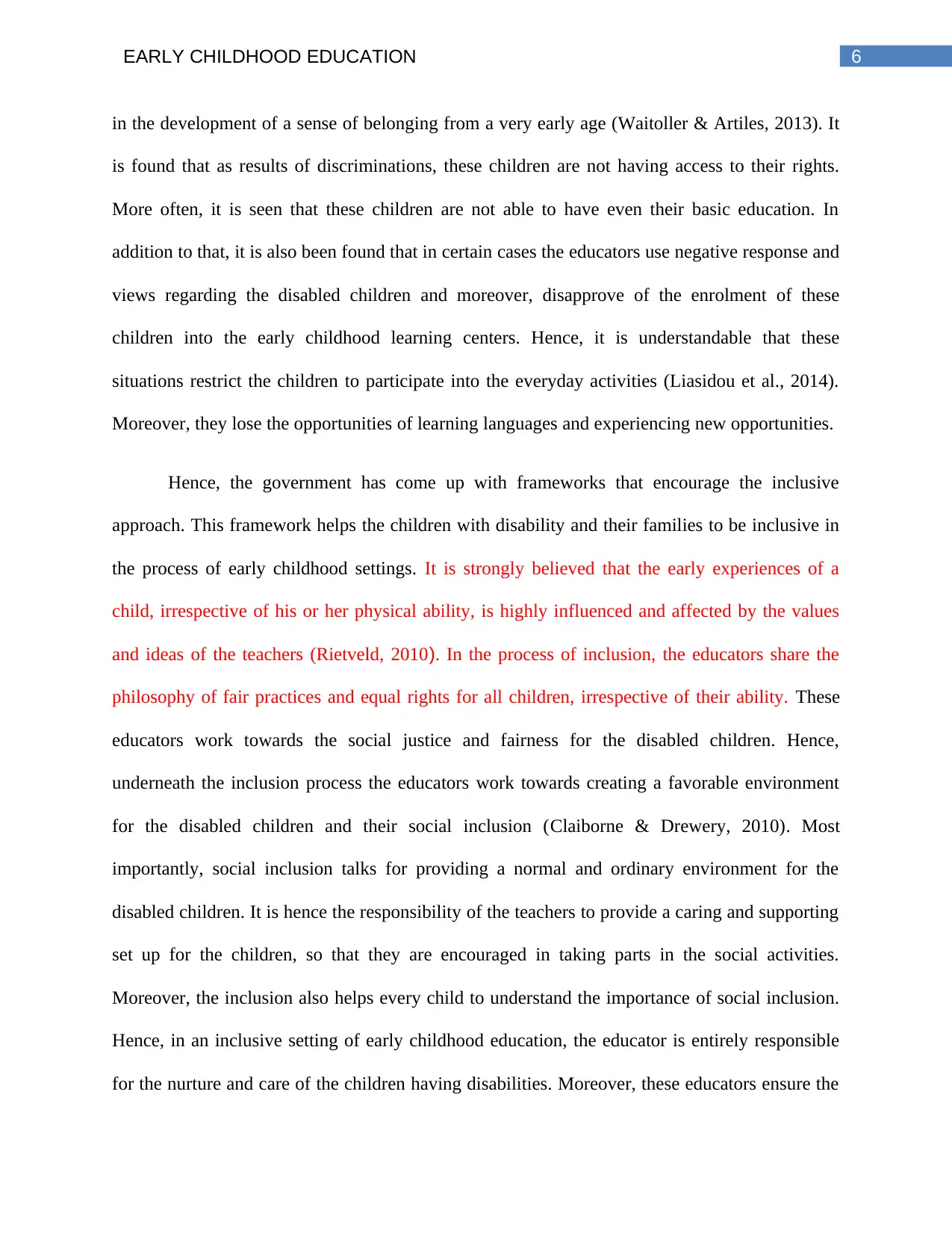
6EARLY CHILDHOOD EDUCATION
in the development of a sense of belonging from a very early age (Waitoller & Artiles, 2013). It
is found that as results of discriminations, these children are not having access to their rights.
More often, it is seen that these children are not able to have even their basic education. In
addition to that, it is also been found that in certain cases the educators use negative response and
views regarding the disabled children and moreover, disapprove of the enrolment of these
children into the early childhood learning centers. Hence, it is understandable that these
situations restrict the children to participate into the everyday activities (Liasidou et al., 2014).
Moreover, they lose the opportunities of learning languages and experiencing new opportunities.
Hence, the government has come up with frameworks that encourage the inclusive
approach. This framework helps the children with disability and their families to be inclusive in
the process of early childhood settings. It is strongly believed that the early experiences of a
child, irrespective of his or her physical ability, is highly influenced and affected by the values
and ideas of the teachers (Rietveld, 2010). In the process of inclusion, the educators share the
philosophy of fair practices and equal rights for all children, irrespective of their ability. These
educators work towards the social justice and fairness for the disabled children. Hence,
underneath the inclusion process the educators work towards creating a favorable environment
for the disabled children and their social inclusion (Claiborne & Drewery, 2010). Most
importantly, social inclusion talks for providing a normal and ordinary environment for the
disabled children. It is hence the responsibility of the teachers to provide a caring and supporting
set up for the children, so that they are encouraged in taking parts in the social activities.
Moreover, the inclusion also helps every child to understand the importance of social inclusion.
Hence, in an inclusive setting of early childhood education, the educator is entirely responsible
for the nurture and care of the children having disabilities. Moreover, these educators ensure the
in the development of a sense of belonging from a very early age (Waitoller & Artiles, 2013). It
is found that as results of discriminations, these children are not having access to their rights.
More often, it is seen that these children are not able to have even their basic education. In
addition to that, it is also been found that in certain cases the educators use negative response and
views regarding the disabled children and moreover, disapprove of the enrolment of these
children into the early childhood learning centers. Hence, it is understandable that these
situations restrict the children to participate into the everyday activities (Liasidou et al., 2014).
Moreover, they lose the opportunities of learning languages and experiencing new opportunities.
Hence, the government has come up with frameworks that encourage the inclusive
approach. This framework helps the children with disability and their families to be inclusive in
the process of early childhood settings. It is strongly believed that the early experiences of a
child, irrespective of his or her physical ability, is highly influenced and affected by the values
and ideas of the teachers (Rietveld, 2010). In the process of inclusion, the educators share the
philosophy of fair practices and equal rights for all children, irrespective of their ability. These
educators work towards the social justice and fairness for the disabled children. Hence,
underneath the inclusion process the educators work towards creating a favorable environment
for the disabled children and their social inclusion (Claiborne & Drewery, 2010). Most
importantly, social inclusion talks for providing a normal and ordinary environment for the
disabled children. It is hence the responsibility of the teachers to provide a caring and supporting
set up for the children, so that they are encouraged in taking parts in the social activities.
Moreover, the inclusion also helps every child to understand the importance of social inclusion.
Hence, in an inclusive setting of early childhood education, the educator is entirely responsible
for the nurture and care of the children having disabilities. Moreover, these educators ensure the
Paraphrase This Document
Need a fresh take? Get an instant paraphrase of this document with our AI Paraphraser
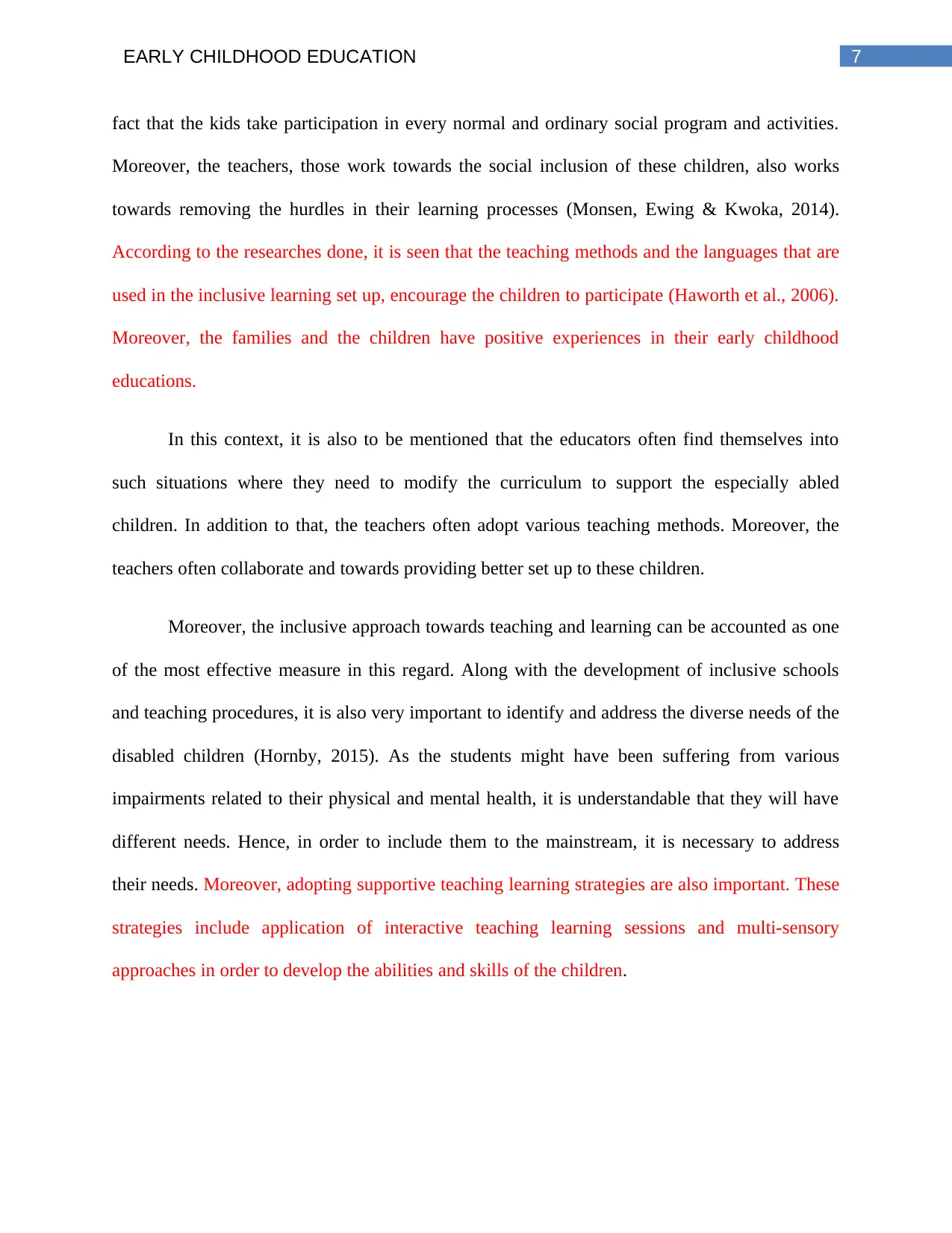
7EARLY CHILDHOOD EDUCATION
fact that the kids take participation in every normal and ordinary social program and activities.
Moreover, the teachers, those work towards the social inclusion of these children, also works
towards removing the hurdles in their learning processes (Monsen, Ewing & Kwoka, 2014).
According to the researches done, it is seen that the teaching methods and the languages that are
used in the inclusive learning set up, encourage the children to participate (Haworth et al., 2006).
Moreover, the families and the children have positive experiences in their early childhood
educations.
In this context, it is also to be mentioned that the educators often find themselves into
such situations where they need to modify the curriculum to support the especially abled
children. In addition to that, the teachers often adopt various teaching methods. Moreover, the
teachers often collaborate and towards providing better set up to these children.
Moreover, the inclusive approach towards teaching and learning can be accounted as one
of the most effective measure in this regard. Along with the development of inclusive schools
and teaching procedures, it is also very important to identify and address the diverse needs of the
disabled children (Hornby, 2015). As the students might have been suffering from various
impairments related to their physical and mental health, it is understandable that they will have
different needs. Hence, in order to include them to the mainstream, it is necessary to address
their needs. Moreover, adopting supportive teaching learning strategies are also important. These
strategies include application of interactive teaching learning sessions and multi-sensory
approaches in order to develop the abilities and skills of the children.
fact that the kids take participation in every normal and ordinary social program and activities.
Moreover, the teachers, those work towards the social inclusion of these children, also works
towards removing the hurdles in their learning processes (Monsen, Ewing & Kwoka, 2014).
According to the researches done, it is seen that the teaching methods and the languages that are
used in the inclusive learning set up, encourage the children to participate (Haworth et al., 2006).
Moreover, the families and the children have positive experiences in their early childhood
educations.
In this context, it is also to be mentioned that the educators often find themselves into
such situations where they need to modify the curriculum to support the especially abled
children. In addition to that, the teachers often adopt various teaching methods. Moreover, the
teachers often collaborate and towards providing better set up to these children.
Moreover, the inclusive approach towards teaching and learning can be accounted as one
of the most effective measure in this regard. Along with the development of inclusive schools
and teaching procedures, it is also very important to identify and address the diverse needs of the
disabled children (Hornby, 2015). As the students might have been suffering from various
impairments related to their physical and mental health, it is understandable that they will have
different needs. Hence, in order to include them to the mainstream, it is necessary to address
their needs. Moreover, adopting supportive teaching learning strategies are also important. These
strategies include application of interactive teaching learning sessions and multi-sensory
approaches in order to develop the abilities and skills of the children.
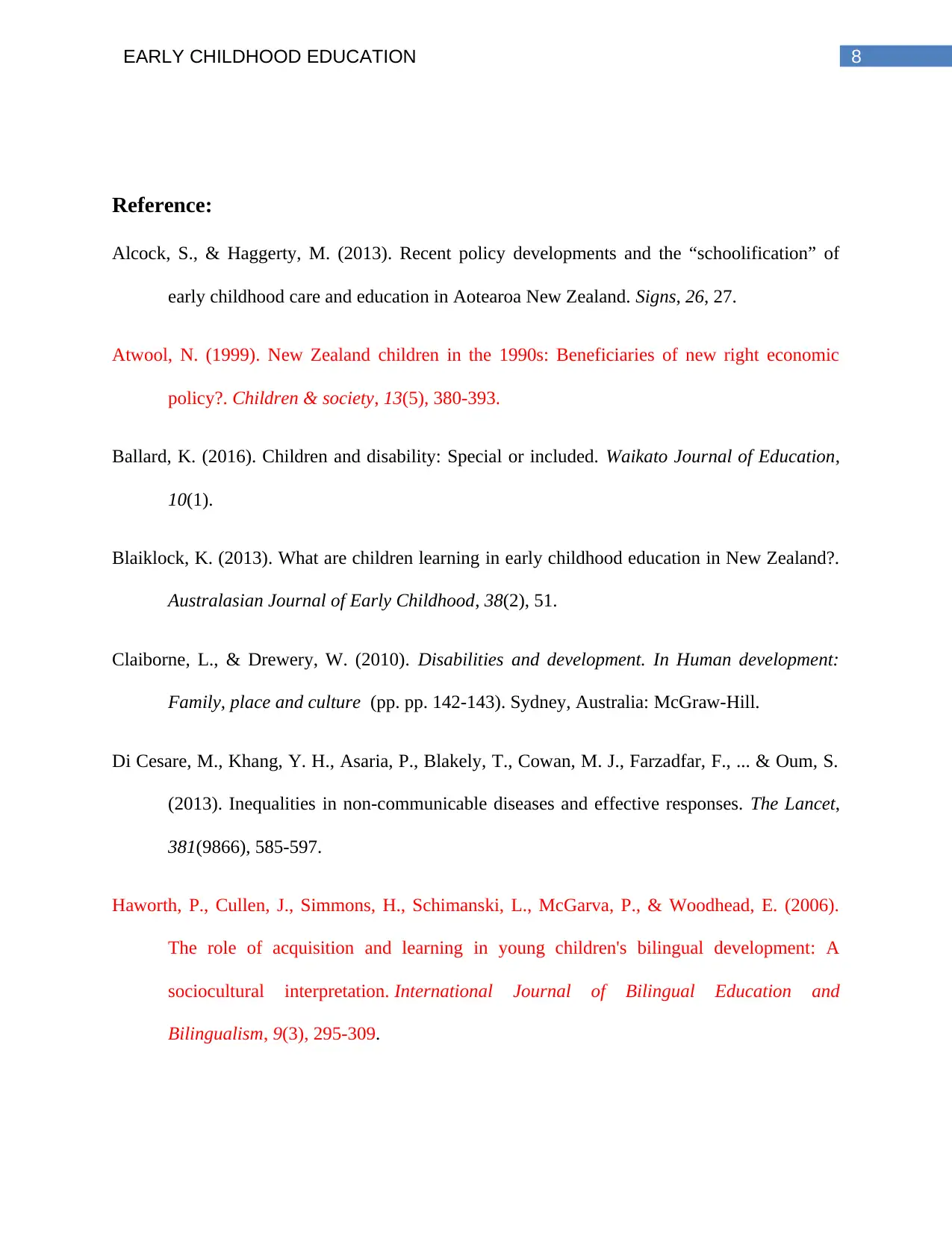
8EARLY CHILDHOOD EDUCATION
Reference:
Alcock, S., & Haggerty, M. (2013). Recent policy developments and the “schoolification” of
early childhood care and education in Aotearoa New Zealand. Signs, 26, 27.
Atwool, N. (1999). New Zealand children in the 1990s: Beneficiaries of new right economic
policy?. Children & society, 13(5), 380-393.
Ballard, K. (2016). Children and disability: Special or included. Waikato Journal of Education,
10(1).
Blaiklock, K. (2013). What are children learning in early childhood education in New Zealand?.
Australasian Journal of Early Childhood, 38(2), 51.
Claiborne, L., & Drewery, W. (2010). Disabilities and development. In Human development:
Family, place and culture (pp. pp. 142-143). Sydney, Australia: McGraw-Hill.
Di Cesare, M., Khang, Y. H., Asaria, P., Blakely, T., Cowan, M. J., Farzadfar, F., ... & Oum, S.
(2013). Inequalities in non-communicable diseases and effective responses. The Lancet,
381(9866), 585-597.
Haworth, P., Cullen, J., Simmons, H., Schimanski, L., McGarva, P., & Woodhead, E. (2006).
The role of acquisition and learning in young children's bilingual development: A
sociocultural interpretation. International Journal of Bilingual Education and
Bilingualism, 9(3), 295-309.
Reference:
Alcock, S., & Haggerty, M. (2013). Recent policy developments and the “schoolification” of
early childhood care and education in Aotearoa New Zealand. Signs, 26, 27.
Atwool, N. (1999). New Zealand children in the 1990s: Beneficiaries of new right economic
policy?. Children & society, 13(5), 380-393.
Ballard, K. (2016). Children and disability: Special or included. Waikato Journal of Education,
10(1).
Blaiklock, K. (2013). What are children learning in early childhood education in New Zealand?.
Australasian Journal of Early Childhood, 38(2), 51.
Claiborne, L., & Drewery, W. (2010). Disabilities and development. In Human development:
Family, place and culture (pp. pp. 142-143). Sydney, Australia: McGraw-Hill.
Di Cesare, M., Khang, Y. H., Asaria, P., Blakely, T., Cowan, M. J., Farzadfar, F., ... & Oum, S.
(2013). Inequalities in non-communicable diseases and effective responses. The Lancet,
381(9866), 585-597.
Haworth, P., Cullen, J., Simmons, H., Schimanski, L., McGarva, P., & Woodhead, E. (2006).
The role of acquisition and learning in young children's bilingual development: A
sociocultural interpretation. International Journal of Bilingual Education and
Bilingualism, 9(3), 295-309.
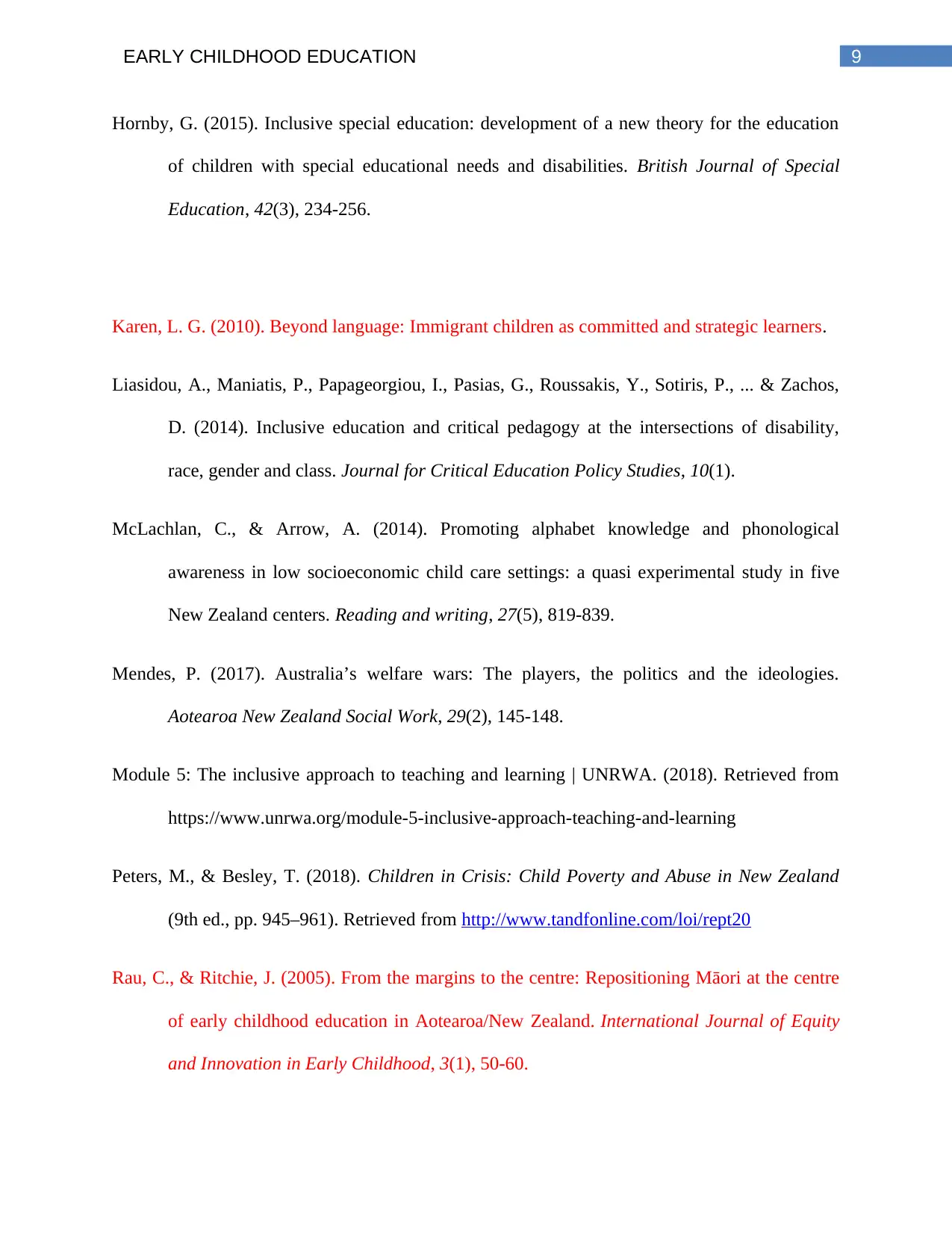
9EARLY CHILDHOOD EDUCATION
Hornby, G. (2015). Inclusive special education: development of a new theory for the education
of children with special educational needs and disabilities. British Journal of Special
Education, 42(3), 234-256.
Karen, L. G. (2010). Beyond language: Immigrant children as committed and strategic learners.
Liasidou, A., Maniatis, P., Papageorgiou, I., Pasias, G., Roussakis, Y., Sotiris, P., ... & Zachos,
D. (2014). Inclusive education and critical pedagogy at the intersections of disability,
race, gender and class. Journal for Critical Education Policy Studies, 10(1).
McLachlan, C., & Arrow, A. (2014). Promoting alphabet knowledge and phonological
awareness in low socioeconomic child care settings: a quasi experimental study in five
New Zealand centers. Reading and writing, 27(5), 819-839.
Mendes, P. (2017). Australia’s welfare wars: The players, the politics and the ideologies.
Aotearoa New Zealand Social Work, 29(2), 145-148.
Module 5: The inclusive approach to teaching and learning | UNRWA. (2018). Retrieved from
https://www.unrwa.org/module-5-inclusive-approach-teaching-and-learning
Peters, M., & Besley, T. (2018). Children in Crisis: Child Poverty and Abuse in New Zealand
(9th ed., pp. 945–961). Retrieved from http://www.tandfonline.com/loi/rept20
Rau, C., & Ritchie, J. (2005). From the margins to the centre: Repositioning Māori at the centre
of early childhood education in Aotearoa/New Zealand. International Journal of Equity
and Innovation in Early Childhood, 3(1), 50-60.
Hornby, G. (2015). Inclusive special education: development of a new theory for the education
of children with special educational needs and disabilities. British Journal of Special
Education, 42(3), 234-256.
Karen, L. G. (2010). Beyond language: Immigrant children as committed and strategic learners.
Liasidou, A., Maniatis, P., Papageorgiou, I., Pasias, G., Roussakis, Y., Sotiris, P., ... & Zachos,
D. (2014). Inclusive education and critical pedagogy at the intersections of disability,
race, gender and class. Journal for Critical Education Policy Studies, 10(1).
McLachlan, C., & Arrow, A. (2014). Promoting alphabet knowledge and phonological
awareness in low socioeconomic child care settings: a quasi experimental study in five
New Zealand centers. Reading and writing, 27(5), 819-839.
Mendes, P. (2017). Australia’s welfare wars: The players, the politics and the ideologies.
Aotearoa New Zealand Social Work, 29(2), 145-148.
Module 5: The inclusive approach to teaching and learning | UNRWA. (2018). Retrieved from
https://www.unrwa.org/module-5-inclusive-approach-teaching-and-learning
Peters, M., & Besley, T. (2018). Children in Crisis: Child Poverty and Abuse in New Zealand
(9th ed., pp. 945–961). Retrieved from http://www.tandfonline.com/loi/rept20
Rau, C., & Ritchie, J. (2005). From the margins to the centre: Repositioning Māori at the centre
of early childhood education in Aotearoa/New Zealand. International Journal of Equity
and Innovation in Early Childhood, 3(1), 50-60.
Secure Best Marks with AI Grader
Need help grading? Try our AI Grader for instant feedback on your assignments.
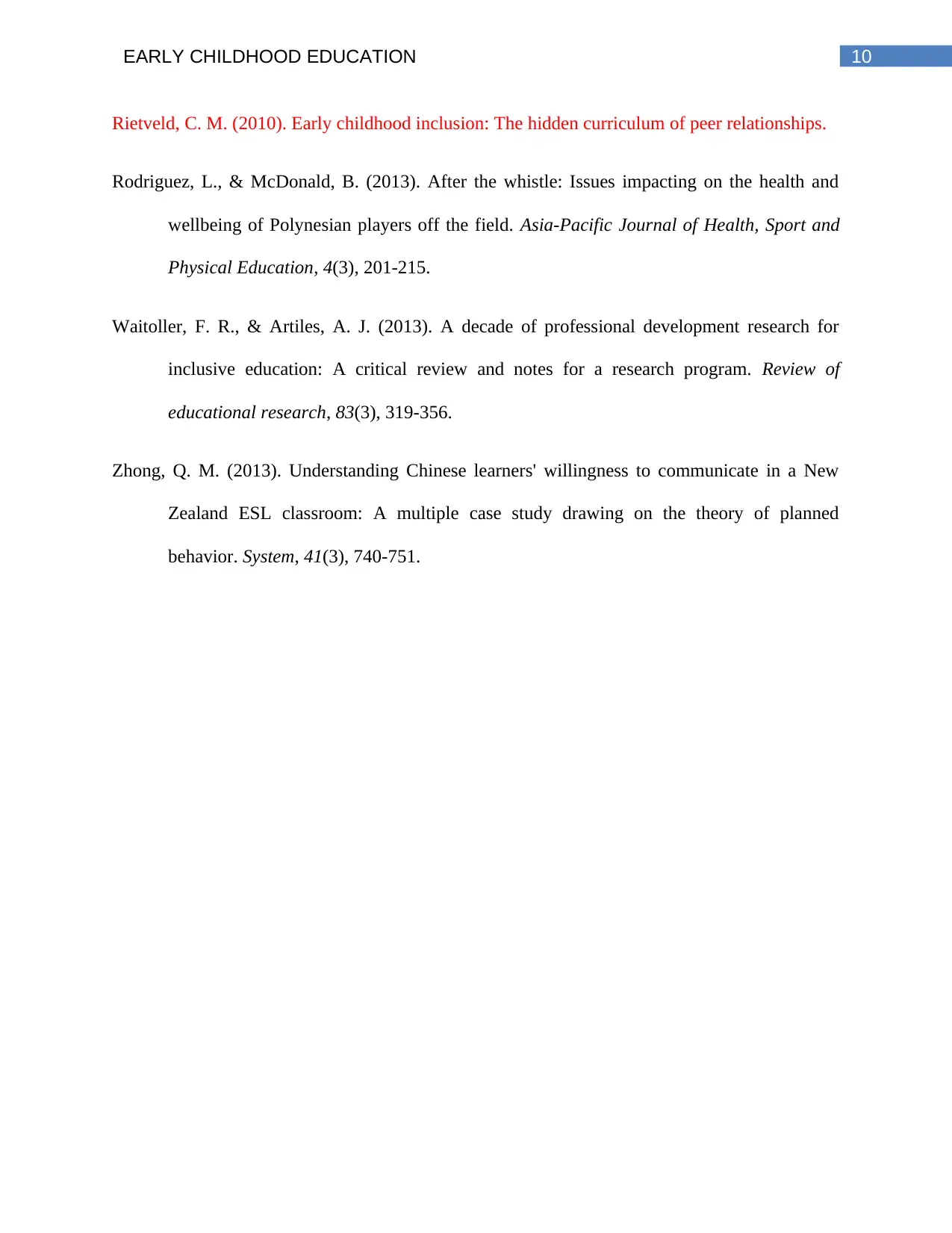
10EARLY CHILDHOOD EDUCATION
Rietveld, C. M. (2010). Early childhood inclusion: The hidden curriculum of peer relationships.
Rodriguez, L., & McDonald, B. (2013). After the whistle: Issues impacting on the health and
wellbeing of Polynesian players off the field. Asia-Pacific Journal of Health, Sport and
Physical Education, 4(3), 201-215.
Waitoller, F. R., & Artiles, A. J. (2013). A decade of professional development research for
inclusive education: A critical review and notes for a research program. Review of
educational research, 83(3), 319-356.
Zhong, Q. M. (2013). Understanding Chinese learners' willingness to communicate in a New
Zealand ESL classroom: A multiple case study drawing on the theory of planned
behavior. System, 41(3), 740-751.
Rietveld, C. M. (2010). Early childhood inclusion: The hidden curriculum of peer relationships.
Rodriguez, L., & McDonald, B. (2013). After the whistle: Issues impacting on the health and
wellbeing of Polynesian players off the field. Asia-Pacific Journal of Health, Sport and
Physical Education, 4(3), 201-215.
Waitoller, F. R., & Artiles, A. J. (2013). A decade of professional development research for
inclusive education: A critical review and notes for a research program. Review of
educational research, 83(3), 319-356.
Zhong, Q. M. (2013). Understanding Chinese learners' willingness to communicate in a New
Zealand ESL classroom: A multiple case study drawing on the theory of planned
behavior. System, 41(3), 740-751.
1 out of 11
Related Documents
Your All-in-One AI-Powered Toolkit for Academic Success.
+13062052269
info@desklib.com
Available 24*7 on WhatsApp / Email
![[object Object]](/_next/static/media/star-bottom.7253800d.svg)
Unlock your academic potential
© 2024 | Zucol Services PVT LTD | All rights reserved.





